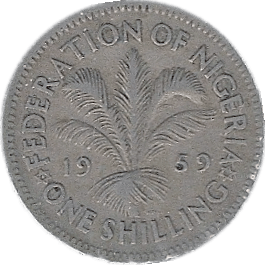Nigerian pound facts for kids
Quick facts for kids Nigerian pound |
|
|---|---|
| User(s) | Nigeria |
| Subunit | |
| 1⁄20 | shilling |
| 1⁄240 | penny |
| Symbol | £ |
| shilling | s or /– |
| penny | d |
| Coins | 1⁄2d, 1d, 3d, 6d, 1/–, 2/– |
| Banknotes | 5/–, 10/–, £1, £5 |
The pound was the money used in Nigeria for many years. It was the official currency from 1907 until 1973. Before 1958, Nigeria used a currency called the British West African pound. After that, Nigeria started printing its own pounds. One Nigerian pound was worth the same as one British pound.
The Nigerian pound was divided into smaller parts. One pound was equal to 20 shillings. Each shilling was then divided into 12 pence. So, one pound was equal to 240 pence! This system was a bit complicated compared to today's money, which usually uses 100 cents to a dollar or naira.
In 1973, Nigeria changed its money system. The pound was replaced by a new currency called the Nigerian naira. This made Nigeria the last country to stop using the old pound, shilling, and pence system.
Coins of the Nigerian Pound
Coins for the Nigerian pound were first made in 1959. They came in several values. These included 1⁄2 penny, 1 penny, 3 pence, and 6 pence. There were also coins for 1 shilling and 2 shillings.
The 1⁄2 penny and 1 penny coins were made of bronze. They had a hole in the middle. The 3 pence coin was made of nickel-brass. It was a smaller, twelve-sided coin. This shape was also used for similar coins in the UK and other places. The higher value coins, like the 1 and 2 shillings, were made from a mix of copper and nickel.
Banknotes of the Nigerian Pound
In 1918, the government made some special emergency banknotes. These were for 1 shilling, 10 shillings, and 20 shillings.
Later, in 1959, the Central Bank of Nigeria started issuing its own banknotes. These notes came in values of 5 shillings, 10 shillings, £1 (one pound), and £5 (five pounds). The Central Bank released three different sets of these banknotes. They were issued in 1958, 1967, and 1968.
See also
- Economy of Nigeria


